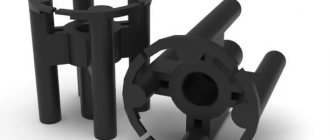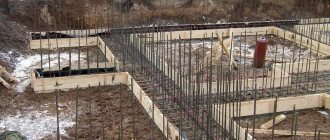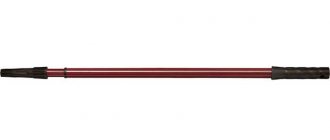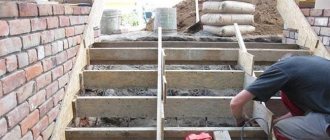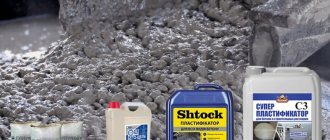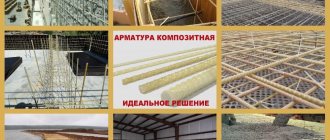The characteristics of the concrete base depend on the quality of the reinforcement. Uniform installation within a concrete structure increases reliability. The layer of concrete increases, protecting the reinforcing mesh from rust; a level installation assumes an even distribution of the load over the surface. A reinforcement clamp will help you cope. Keeps the metal structure at a distance from the formwork.
Stand for fittings
Tasks of clamps
The task of the products is to maintain the correct position of the reinforcement cage in relation to the base. They are for one-time use. After pouring the concrete, they remain inside the base. The material should be inexpensive. Thanks to proper installation, the process of pouring the solution is accelerated several times.
Features, Benefits
During reinforcement, additional parts are used - stands for attaching metal rods. They are made of plastic and are called retainers. They have good technical performance and are in demand:
- Eco-friendly.
- Withstands exposure to ultraviolet rays and low temperatures.
- Inert to alkaline, aggressive environments.
- Versatile.
An important point is that they can be used for any type of concrete base.
Purpose - to provide gaps between the surface of concrete and the reinforcing frame. Advantages:
- Possibility of filling with mortar, part of the structure will not budge.
- It is possible to maintain the distance from the surface to the reinforcing frame; the metal is not subject to corrosive damage.
- Plastic products provide stability to the reinforcement frame.
- It is possible to increase the service life of metal products.
Classification, limits of application
Reinforcing structure fasteners can be used in several structures:
- When forming floor slabs.
- For the construction of walls.
- While pouring the foundation.
When creating a columnar, bored foundation, star-shaped fixing elements are used. The structure is a mesh element through which the concrete mixture flows freely.
When installing horizontal reinforcing structures, “racks” are used. It is possible to provide a protective layer thickness of 15-35 mm, with a reinforcement diameter of 19-25 mm.
If a preliminary concrete surface has been prepared, you can use a “chair”. It has good load-bearing capacity and is used when installing high-thickness monolithic slabs. Provides a protective layer of 15-60 mm, with a section diameter of 14-24 mm.
On unstable surfaces, such as crushed stone, sand cushions, “pyramid” models are used. They can withstand a concrete layer of 15-90 mm, with a reinforcement diameter of up to 16 mm.
What are fasteners made of?
A reinforcement clamp is an embedded part for forming a certain thickness of the protective layer. The main purpose of the element is to fix reinforcing bars, frames and reinforcing mesh. Fasteners are produced from high-strength polyethylene using injection molding technology. Plastic materials are resistant to corrosion and oxidation and can withstand temperature changes.
Not only the material of the clamps matters, but also the distance between them. It is selected based on certain conditions. But, as a rule, the elements are placed in a checkerboard pattern. Approximate consumption is from 4 to 10 pieces per square meter of concrete.
Types of fastenings
Manufactured from plastic, which has high strength and availability, they have good performance. Sometimes, elements taken from the formwork are used. The solution has a drawback - after pouring the concrete, the parts must be removed. The resulting cavities are filled with concrete mixture. Types of fixation elements according to the location of the reinforcement:
- Supporting. Used for horizontal structures - “cube”, “chair”.
- Wall. Used for vertical reinforced structures.
- Universal.
- Special. Necessary for the formation of a cavity in the base. This class includes tubes and plugs.
"High Chair"
Used when pouring monolithic foundations with a large load on the base surface. It can be simple, reinforced. In the second option, instead of four legs, five are used. The “chair” copes with fixing rods with a cross-section of 4-16 mm. It is possible to form a layer of concrete on top of the reinforcement frame - 15-40 mm.
High chair with stand
"Cube"
Designed for placing reinforcing inserts under the rods. According to SNiP, 6-10 products are required per 1 m2. When the product is turned over, the thickness of the protective concrete base changes. By turning the “Cube” over, you can achieve a layer thickness of up to 35-80 mm.
Cube with stand
"Cone"
Used for assembling panel formwork. A coupling screw is installed between the two shields and twisted into “cones”. Before installation, it is necessary to put on the tube included in the kit to free the threaded connection from concrete. After pouring the foundation, you can remove the threaded rod without damage (the tube remains inside).
Cone with tube
"Rack"
The “stand” looks like a “cube”. Features a cylindrical shape that can withstand heavy loads. Purpose - fixation of a reinforced frame on loose soil. It can be used with an additional element that reduces the pressure on the ground surface.
Rack
Used for fixing horizontal rods with a diameter of up to 16 mm. Creates a protective layer of 12-40 mm. Has good load-bearing abilities. When installing additional elements, it copes with the pressure load of the reinforcing structure. Consumption of products per square meter – 6-10 pcs.
"Star"
The main place for the “asterisk” is vertical structures, but they are also suitable for horizontal ones. It has a snap mechanism that securely fastens the product to the fittings. Protection layer - 15-75 mm.
Star
Fixation can be done on metal rods with a diameter of up to 22 mm. Often used when installing vertical concrete structures. One square meter of working surface will require 4-8 products.
Multi-level
Fixation of several levels is carried out. The product does not differ in appearance from simple parts, but has clamps for fastening to fittings.
Multi-level
Choice, installation features
“Stars” are popular – they are universal.
When choosing an “asterisk” as a fastening element, consider the quality of the material. Poorly made fasteners have a short service life and break into several parts upon first use.
Consider the thickness of the product and the quality of workmanship. It should be flexible and not break when pressed. A simple method is to put the part on an object corresponding to the cross-sectional diameter of the reinforcing rod. If the product has retained its integrity, it can be used when fixing reinforcing rods.
Basic requirements for fasteners for reinforcement
Must be made of durable material. The quality determines how heavy loads a concrete foundation can withstand. To check the chair and cube, just stand on them. If they remain intact, slightly deformed, this is normal.
Elements that are installed on the ground require additional parts - stands to reduce pressure.
Fasteners for fittings: purpose and types, features of choice
The characteristics of concrete monoliths largely depend on the quality of the reinforcement, which distributes static and dynamic loads.
Therefore, it must be correctly oriented in the thickness of the structural element and reliably protected from the external environment with a layer of concrete.
For this purpose, reinforcement clamps are used - embedded elements designed to secure and hold the reinforcing structure until the concrete solution sets.
Tasks of clamps
The main function of the frame and protective layer clamps is to maintain the correct position of the reinforcement inside the concrete monolith. The embedded elements installed before pouring remain in the mortar after it hardens.
This is a consumable item, so their price should be low. Correctly installed clamps for the frame reinforcement and protective layer significantly speed up and simplify concreting and ensure uniform distribution of the load on the frame.
Types of fastenings
The clamps are made of durable plastic that is resistant to aggressive influences. This ensures the required performance indicators and an acceptable price for the material. Less commonly used are elements that are parts of the formwork, after removing which the resulting cavities must be filled with concrete. There are different types of clamps based on the location of the reinforcement they hold:
- Supporting – for fixing the reinforcement frame horizontally, for example, a cube, a chair;
- Wall - designed for fastening vertical conductors, for example, an asterisk;
- Universal – combines the characteristics of horizontal and vertical options;
- Special - used in cases to create cavities in a concrete monolith, for example, tubes and plugs.
"High Chair"
This is the most popular type of clamps for horizontal fittings. It is used when pouring floors, slabs, and other elements with large loaded surfaces.
The universal shape of the fastener for “chair” type fittings is a cylinder with four cut grooves and upper crossbars. The standard design has four legs, the reinforced design has five.
This type reliably holds metal elements with a diameter of 4-16 mm, allowing a layer of mortar of 15-40 mm above them.
To use clamps on loose soils, they are supplemented with a base element that prevents them from sinking.
It is also used in cases where waterproofing material is laid under a metal frame so that the legs do not break through it when pouring.
There is a modernized version of this element, called “herringbone” with 4 inclined jumpers, with the possibility of laying protection with a thickness of 20 to 35 mm.
"Cube"
“Cube” fastenings are designed for fastening reinforcing elements of foundations, horizontal floors and bridges. Its body can be installed so as to obtain the required distance between the frame elements and the required protective layer. According to SNiP standards, depending on the diameter of the metal rod, 6-10 attachment points are installed per square meter.
Several sizes of the “cube” clamp are offered for horizontal fittings, depending on the connectors and the thickness of the plastic wall. By installing it on different faces, you can achieve a protective layer thickness of 35-80 mm and fix a rod with a diameter of up to 40 mm.
"Cone"
Clamps for cone-type reinforcement are installed at the ends of the stop tubes through which the tie bolts pass and rest against the formwork, preventing solution from entering the tube.
Failure to use these embeds will result in the loss of tie bolts, which will fall into the thickness of the hardened concrete. For each of these bolts you will need two plastic tips, which are removed after dismantling the formwork and can be reused.
You can avoid conical clamps by using reinforcement with clamps to hold the formwork, but this will cost more.
"Rack"
The design of the “stand” reinforcement clamp is similar to a “cube”. It has a cylindrical shape that can withstand heavy loads. It is well suited for the lower rows of reinforcement, for loose soil; it is additionally equipped with a “base” element, which reduces the pressure on the surface.
The “stand” reinforcement clamp is designed for horizontal surfaces and is attached to reinforcement with a diameter of up to 16 mm. With its help, you can create reinforced structures with a protective layer of 12-40 mm.
Using special fasteners, the rack can support several rows of reinforcement cage, while maintaining the overall level of the structure.
Material consumption, as for other horizontal models, is 6-10 elements per square meter.
"Star"
Star reinforcement clamps are of the vertical type, but can also be attached to horizontal reinforcement levels. It snaps onto a metal rod and, in accordance with its own diameter, allows the application of a uniform protective layer 15-75 mm thick.
This type of fastening securely snaps onto reinforcement with a diameter of up to 22 mm, suitable for walls, columns, and other concrete structures with vertical surfaces. Consumption, depending on the type of surface, is from 4 to 8 elements per square meter.
Multi-level
Clamps for multi-level fittings are gaining popularity due to their versatility and low price. Technologically, they are simple clamps connected by special fasteners.
This design allows you to strengthen several levels of reinforcement, connecting them to each other, increasing the strength and reliability of the monolith by increasing the protective layer.
The consumption of embedded elements remains standard - up to 10 per square meter.
Elements of the “chair” or “cube” type are often used as multi-level clamps. This is possible when they are equipped with fastenings that allow them to be built up into several floors, like a construction set. The clamps fixed in the grooves easily withstand increased loads, do not move or burst when pouring concrete.
Do-it-yourself reinforcement clamps
In private construction, when performing small volumes of work, it is possible to use homemade clamps for the protective layer of reinforcement. Often, available materials such as bricks, wooden supports, stone, and tiles are used for this.
The worst option is wooden elements that are too hygroscopic. They change shape, as a result, the integrity of the reinforcement frame is violated, and over time they collapse, leaving voids unforeseen in the design. After this, cracks appear in the concrete and its strength decreases significantly. Another unsuccessful material is plastic bottles, which deform under load.
Previously, separately cast concrete elements in the form of cubes or parallelepipeds were used to create a protective layer. They adhere well to the monolith, maintaining its strength characteristics, but cannot secure the reinforcement firmly enough, often shifting during pouring, preventing the load from being evenly distributed. Therefore, they are now being abandoned, installed only in extreme cases.
High-quality hand-made reinforcement clamps are almost as good as industrial ones and are made from cheap improvised materials:
- Plastic pipe. It must be strong enough, resistant to corrosion, and easy to handle with tools. This allows you to make the necessary holes and clamps for fittings in it.
- Plastic socket boxes with specially made cuts.
- Metal rod. It is used in private construction with small loads on reinforced concrete mass. Among builders, this species was called “frog”.
- Structures made of metal rods and rings. This is one of the types of “frog” - a rod is inserted into the ring and the solution is poured. After this, the entire concrete monolith is made.
Selection and installation features
The first criterion for choosing fasteners for fittings is the type. Popular star-type reinforcement clamps are a universal solution for fastening vertical and horizontal arrays of metal rods.
This element is very demanding on the quality of the material from which it is made, since when fastened, low-quality sprockets split into several parts.
Therefore, when choosing, you need to ensure that the plastic is sufficiently thick and of its quality; it must be durable and elastic.
The most reliable test is to simply put the clamp on an object of suitable diameter for the fitting. If it does not collapse, it can be used in construction.
When selecting clamps for horizontal structures, you need to check their strength, since they experience high loads. To check the “cube” and “chair” you just need to stand up these elements; under the weight they may be slightly deformed, but not burst.
We must not forget that when strengthening reinforcement on the ground, the fastening parts must be equipped with additional elements - supports. They reduce the pressure of the structure and do not sink into the ground, leaving the metal above the surface.
As a result, it is completely covered with the solution and does not corrode, which extends its service life.
For all types of clamps, the core diameter is important. Select by markings - FS30 for a rod of 30 mm, FS50 for a diameter of 50 mm, etc. It is important to immediately calculate the number of fasteners per linear or square meter.
According to GOST, the number of these elements per m² should be in the range of 4-10 pieces. It must be taken into account that the fewer fasteners you have to use, the stronger the reinforced concrete structure will be.
At the same time, their insufficient quantity will lead to a violation of the integrity of the reinforcement and a decrease in the quality of the protective layer.
Calculator
Use an online calculator to calculate the required number of fasteners and their cost.
The technology of using fasteners for the protective layer of reinforcement can significantly improve the quality of reinforced concrete structures. Uniform distribution of mechanical stress in the middle of the structure and a high-quality protective layer extend the service life of the concrete monolith and make it resistant to corrosion.
What can you make your own fasteners from?
From pipe scraps
You can take a piece of plastic pipe and drill holes on the sides to install the clamp on the crosshairs of the reinforcing mesh. The fixing element can be used to hold one rod; you will have to drill not four holes, but two.
From a rod
The “frog” is installed between the reinforcing mesh to secure the top row. The product provides additional strength to the entire structure. When compared with tying a reinforcing structure onto “soldiers” (vertically installed scraps of metal rods), the method significantly speeds up installation.
Made from rod and metal rings
It looks like a “frog”, but has differences - a metal rod, which is installed in a ring of the same material, is poured with concrete. Used to secure the top floor of the reinforcing mesh. The fixing element is a ring. Reinforcing mesh is laid on it. At the bottom, a U-shaped rod is attached to the metal frame.
What fasteners should not be made from
Bad materials for parts are wood: stands made of small planks, installed pegs, multilayer plywood laid with plates, chipboard. Reasons: wood absorbs moisture very strongly and can affect the quality of concrete due to rapid drying; has poor strength, soaked in moisture, it only gets worse.
You cannot use plastic bottles; they have poor load-bearing capacity; when pouring concrete, the bottle will be crushed.
Brick is not the best option. Reasons: absorbs liquid and breaks down over time.
Requirements for reinforcement clamps
When constructing buildings, the fundamental conditions for the durability of the structure are the correct installation of the supporting frame, enclosed in concrete mortar. The duration of use of the object, its safety and strength depend on the high-quality fixation of metal rods. It allows you to create the necessary protective layer of the required thickness, a given thickness between the reinforcement and the formwork panel.
The clamps are installed just before the mortar is poured into the created formwork system. Using polymer products, strong fastening of metal rods in the formwork is ensured, and the distance between the panels and the frame is maintained. This design eliminates the appearance of various defects on walls, ceilings, columns, door and window openings.
The metal frame begins at:
- laying reinforcing bars on the base;
- securing the intersection with wire.
Temporary supports can be used. It is necessary to install reinforcement clamps under all intersections of rods to ensure compliance with the technological gaps.
Protective layer of concrete and its functions
The distinctive properties of reinforced concrete are explained by the unique combination of physical and chemical properties of its components. The metal frame works in tension, while the concrete mass has high compressive strength. They have the same coefficient of thermal expansion. The hardened solution turns into an array of artificial stone with an alkaline environment, which becomes an excellent insulator for steel frame elements from corrosion. This insulation is effective when, after concreting, the distance between the reinforcement bars and the surface of the finished product is sufficient to prevent the penetration of water, oxygen, and other aggressive substances through the pores of the concrete to the surface of the metal products. The minimum value of this distance (usually 10-40 mm), called a protective layer, depends on the conditions of further operation of the reinforced concrete product or structure and the influence of various factors.
Compliance with the protective layer is a guarantee of the strength and reliability of the structure being built.
Building codes define the requirements for the thickness of the protective layer. After all, a thick layer increases the load on the frame, increases the weight of the structure and is more expensive, while a thin layer partially loses its functional characteristics. Determining the required concrete thickness is influenced by:
- type of structure being built (wall, column, staircase, foundation, ceiling);
- diameter of the reinforcement used;
- external environment and climatic zone (temperature range, maximums and differences; humidity; contact with the ground and others).
According to the standards, in the most common cases, the following recommendations on its thickness are relevant for regulating the protective layer of concrete:
- rooms with normal or low humidity - at least 20 mm;
- wet rooms without waterproofing – 25 mm or more;
- unprotected external surfaces of buildings - at least 30-40 mm;
- part of the structure buried in the ground that does not have additional protection – 40-76 mm;
- foundation – from 40 mm;
- floors up to 25 cm thick - from 12 mm; more thickened - from 17 mm.
Special magnetic control sensors help to find out the actual depth of reinforcement in finished reinforced concrete structures.

